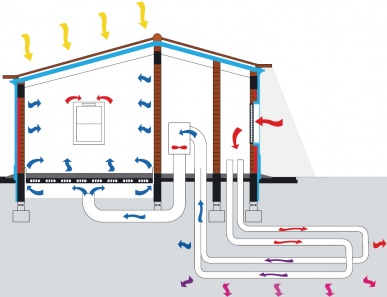Earth to air heat exchangers
Contents |
[edit] Introduction
An earth-to-air heat exchanger draws ventilation supply air through buried ducts or tubes. As the temperature of the ground below 3m is practically constant, it substantially reduces ambient air temperature fluctuations. It therefore provides space conditioning throughout the year, with the incoming air being heated in the winter and cooled in the summer by means of earth coupling.
[edit] System options
Systems can be driven by natural stack ventilation, but usually require mechanical ventilation. In some cases air is circulated via air handling units, allowing filtering and supplementary heating/cooling. A simple controller can be used to monitor inlet and outlet temperatures, as well as indoor air temperatures. Ground coupling ducts or tubes can be of plastic, concrete or clay – the material choice is of little consequence thermally due to the high thermal resistance of the ground.
Earth-to-air heat exchangers are suited to mechanically ventilated buildings with a moderate cooling demand, located in climates with a large temperature differential between summer and winter, and between day and night. Location of the ducts in sand or gravel below the water level, where there is moving ground water, gives the best performance, however, the presence of ground water involves extensive sealing precautions.
[edit] Size and output
The optimum pipe length is a function of pipe diameter and air velocity. Small pipe diameters of between 200 and 300mm are thermally more efficient. Pipes should be buried at a minimum
depth of 2m and separated by 1-2m to allow heat dissipation. The optimum air velocity is typically 2m/s.
Under constant load, the cooling capacity of the ground may become exhausted and, therefore, generally it is not possible to meet high loads. With high loads, two separate duct systems could be considered – one for use in the morning and one for use in the afternoon.
A bypass can be used to improve the performance of the system during periods when the ambient air temperature can meet the cooling requirements. In unoccupied periods when the ambient air temperature falls below the surface temperature in the ducts, night cooling can be used to pre-cool the system.
The ground temperature is based on ‘undisturbed’ conditions. When the ducts are installed beneath the building, or even within a built up area, this will be affected substantially. The effect that the duct has on the ground temperature also needs to be considered. Optimisation of the design requires a complete thermal simulation of the system.
In principle, these are low-cost systems – the excavation is the major part of the installation cost. Maintenance is minimal, but regular inspection and cleaning of the ducts is recommended.
[edit] Summary
Earth-to-air heat exchangers can be used on new buildings or refurbishments to provide free cooling in the summer and pre-heating of air in the winter. They have high capital costs, but over the life of the system can yield substantial savings.
This article was created by --Buro Happold 17 March 2013, based on a 2008 article in 'Patterns'.
[edit] Related articles
- Coefficient of Performance CoP.
- Dynamic thermal modelling of closed loop geothermal heat pump systems.
- Geothermal energy.
- Geothermal pile foundations.
- Ground energy options
- Ground preconditioning of supply air.
- Ground source heat pumps.
- Renewable energy sources: how they work and what they deliver: Part 3: Electrically driven heat pumps DG 532 3.
- Thermal labyrinths.
Featured articles and news
The UK's Modern Industrial Strategy: A 10 year plan
Previous consultation criticism, current key elements and general support with some persisting reservations.
Building Safety Regulator reforms
New roles, new staff and a new fast track service pave the way for a single construction regulator.
Architectural Technologist CPDs and Communications
CIAT CPD… and how you can do it!
Cooling centres and cool spaces
Managing extreme heat in cities by directing the public to places for heat stress relief and water sources.
Winter gardens: A brief history and warm variations
Extending the season with glass in different forms and terms.
Restoring Great Yarmouth's Winter Gardens
Transforming one of the least sustainable constructions imaginable.
Construction Skills Mission Board launch sector drive
Newly formed government and industry collaboration set strategy for recruiting an additional 100,000 construction workers a year.
New Architects Code comes into effect in September 2025
ARB Architects Code of Conduct and Practice available with ongoing consultation regarding guidance.
Welsh Skills Body (Medr) launches ambitious plan
The new skills body brings together funding and regulation of tertiary education and research for the devolved nation.
Paul Gandy FCIOB announced as next CIOB President
Former Tilbury Douglas CEO takes helm.
UK Infrastructure: A 10 Year Strategy. In brief with reactions
With the National Infrastructure and Service Transformation Authority (NISTA).
Ebenezer Howard: inventor of the garden city. Book review.
The Grenfell Tower fire, eight years on
A time to pause and reflect as Dubai tower block fire reported just before anniversary.
Airtightness Topic Guide BSRIA TG 27/2025
Explaining the basics of airtightness, what it is, why it's important, when it's required and how it's carried out.
Construction contract awards hit lowest point of 2025
Plummeting for second consecutive month, intensifying concerns for housing and infrastructure goals.
Understanding Mental Health in the Built Environment 2025
Examining the state of mental health in construction, shedding light on levels of stress, anxiety and depression.
The benefits of engaging with insulation manufacturers
When considering ground floor constructions.
Lighting Industry endorses Blueprint for Electrification
The Lighting Industry Association fully supports the ECA Blueprint as a timely, urgent call to action.

























